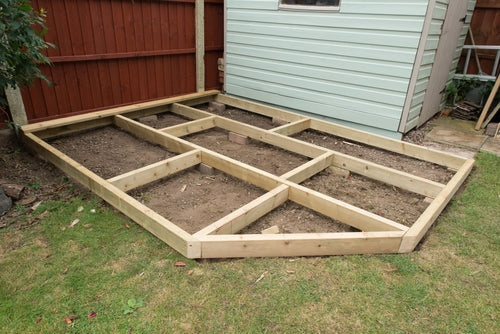
How to choose the best shed base
Planning the materials for your garden shed can be a hassle. With so many options, each with various benefits, it’s hard to narrow it down to just one.
At Atlas Sheds, we are here to run you through the most popular shed base options. We have explored the pros and cons of each to help you make an informed decision.
Browse our range of garden sheds for durable and high-quality structures whilst you’re here.
Shed purpose and requirements
Depending on the primary purpose and size of your shed, certain materials may be more suitable.
If you are using your shed to store tools and equipment, a durable base is crucial. For a workshop, consider a base that can withstand heavy machinery and foot traffic.
If you’re creating a garden or office studio, the base must have a level surface and provide good insulation properties. For those installing a greenhouse, this requires a stable, level surface that offers excellent drainage and stability.
To determine the size of your shed, measure the dimensions and calculate how much base is needed. A heavier shed will require a stronger base to prevent sinking or shifting.
Types of shed bases
There are various types of shed bases to choose from with their own range of benefits:
1. Concrete slab
Concrete is a robust and durable material that can support heavy sheds and prevent decay. This requires minimal cleaning and upkeep, perfect for busy schedules and frequent use.
For those building a workshop or tool storage, this is the perfect option. However, thorough site preparation, including excavation and formwork, is necessary for a concrete base.
This is also an expensive option, making it less suitable for those with a lower budget.
2. Wooden decking
Wooden decking is a beautiful option, enhancing the aesthetic of your garden. This provides elevation, protecting your shed from dampness and reducing mildew and rot.
This is easy to install for those with a DIY project. However, wood decking requires regular maintenance, including staining and sealing, for protection from rot.
Although this is relatively durable, its longevity depends on the type of wood used and your local weather conditions.
3. Gravel or stone pad
This is a more budget-friendly option compared to concrete or wooden decking.
Gravel and stone pads provide excellent natural drainage. This prevents water from pooling around your shed by allowing the rainwater to percolate into the ground. Due to this, the risk of rotting, mould formation, and water damage is reduced.
Relatively easy to install, this option is perfect for DIY projects, and it can support various shed sizes and weights. However, this isn’t as stable as concrete, and it requires periodic maintenance to keep the base in great condition.
4. Plastic grids
For our environmentally conscious customers, plastic grids are the perfect eco-friendly solution to a shed base.
These are made from recycled materials and include a simple interlock system for DIY installation. Plastic grid systems offer outstanding drainage capabilities, allowing the water to pass through the grid opening into the ground, reducing the risk of mould and rot.
For larger or heavier sheds, this is the perfect option. Its even distribution of weight reduces sinking or shifting for a stable structure. However, whilst this is cost-efficient due to its durability and low maintenance, the initial price may be more expensive than other options.
The longevity of your shed will also depend on the materials used for your plastic grid base.
5. Timber Bearers
Timber bearers provide an essential barrier between the shed's structure and the ground by elevating the shed above the surface.
This extends the lifespan of the shed, protecting it from moisture exposure. This is also a budget-friendly alternative to concrete slabs and plastic grids.
For DIY installation, this is an easy, straightforward process. The timber bearers can be adapted to accommodate various sizes and weight of the shed by adjusting the spacing and numbers.
However, this base is more susceptible to rot and insect infestations than others. This means that it requires frequent re-treatment with wood preservatives and replacement of any deteriorated bearers.